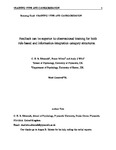Feedback can be superior to observational training for both rule-based and information-integration category structures
| dc.contributor.author | Edmunds, CER | |
| dc.contributor.author | Milton, F | |
| dc.contributor.author | Wills, Andy | |
| dc.date.accessioned | 2014-08-12T08:16:00Z | |
| dc.date.accessioned | 2014-08-12T08:16:53Z | |
| dc.date.available | 2014-08-12T08:16:00Z | |
| dc.date.available | 2014-08-12T08:16:53Z | |
| dc.date.issued | 2015-01-09 | |
| dc.identifier.issn | 1747-0218 | |
| dc.identifier.issn | 1747-0226 | |
| dc.identifier.uri | http://hdl.handle.net/10026.1/3064 | |
| dc.description.abstract |
The effects of two different types of training on rule-based and information-integration category learning were investigated in two experiments. In observational training, a category label is presented, followed by an example of that category and the participant's response. In feedback training, the stimulus is presented, the participant assigns it to a category and then receives feedback about the accuracy of that decision. Ashby, Maddox, and Bohil (2002) reported that feedback training was superior to observational training when learning information-integration category structures, but that training type had little effect on the acquisition of rule-based category structures. These results were argued to support the COVIS dual-process account of category learning. However, a number of non-essential differences between their rule-based and information-integration conditions complicate interpretation of these findings. Experiment 1 controlled, between category structures, for participant error rates, category separation, and the number of stimulus dimensions relevant to the categorization. Under these more controlled conditions, rule-based and information-integration category structures both benefitted from feedback training to a similar degree. Experiment 2 maintained this difference in training type when learning a rule-based category that had otherwise been matched, in terms of category overlap and overall performance, with the rule-based categories used in Ashby et al. These results indicate that differences in dimensionality between the category structures in Ashby et al. is a more likely explanation for the interaction between training type and category structure than the dual-system explanation they offered. | |
| dc.format.extent | 1203-1222 | |
| dc.format.medium | Print-Electronic | |
| dc.language | en | |
| dc.language.iso | en | |
| dc.publisher | SAGE Publications | |
| dc.relation.replaces | http://hdl.handle.net/10026.1/3063 | |
| dc.relation.replaces | 10026.1/3063 | |
| dc.subject | Categorization | |
| dc.subject | Explicit | |
| dc.subject | Feedback | |
| dc.subject | Implicit | |
| dc.subject | COVIS | |
| dc.subject | Competition between verbal and implicit systems | |
| dc.title | Feedback can be superior to observational training for both rule-based and information-integration category structures | |
| dc.type | journal-article | |
| dc.type | Article | |
| plymouth.author-url | http://www.willslab.co.uk/ | |
| plymouth.issue | 6 | |
| plymouth.volume | 68 | |
| plymouth.publication-status | Published | |
| plymouth.journal | Quarterly Journal of Experimental Psychology | |
| dc.identifier.doi | 10.1080/17470218.2014.978875 | |
| plymouth.organisational-group | /Plymouth | |
| plymouth.organisational-group | /Plymouth/Admin Group - REF | |
| plymouth.organisational-group | /Plymouth/Admin Group - REF/REF Admin Group - FoH | |
| plymouth.organisational-group | /Plymouth/Faculty of Health | |
| plymouth.organisational-group | /Plymouth/Faculty of Health/School of Psychology | |
| plymouth.organisational-group | /Plymouth/REF 2021 Researchers by UoA | |
| plymouth.organisational-group | /Plymouth/REF 2021 Researchers by UoA/UoA04 Psychology, Psychiatry and Neuroscience | |
| plymouth.organisational-group | /Plymouth/Research Groups | |
| plymouth.organisational-group | /Plymouth/Research Groups/Institute of Health and Community | |
| plymouth.organisational-group | /Plymouth/Users by role | |
| plymouth.organisational-group | /Plymouth/Users by role/Academics | |
| dc.publisher.place | England | |
| dcterms.dateAccepted | 2014-07-05 | |
| dc.identifier.eissn | 1747-0226 | |
| dc.rights.embargoperiod | Not known | |
| rioxxterms.versionofrecord | 10.1080/17470218.2014.978875 | |
| rioxxterms.licenseref.uri | http://www.rioxx.net/licenses/all-rights-reserved | |
| rioxxterms.licenseref.startdate | 2015-01-09 | |
| rioxxterms.type | Journal Article/Review |


